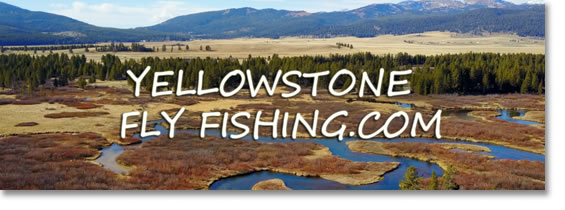Yellowstone National Park - Northwest
This
section contains four of the Park's most popular rivers: the Madison,
Gallatin, Gardner, and Gibbon. All are easily accessible by car and rated
blue-ribbon trout streams. The U.S. Fish and Wildlife Service rates the
Madison the world's second best trout stream; the Yellowstone River is
first.
In The Living River (Nick Lyons
Books, New York, 1979), Charles Brooks described the Madison River as
the world's largest chalkstream. He wrote that its waters are rich in
calcium bicarbonate-the mineral most crucial to aquatic life and the
base of the food chain that nourishes the wild trout for which this
river is world famous.
The Shoshone called the Gallatin River Cut-tuh-o'-gwa, or "swift river." The Gallatin is this
and much more. Its icy waters hold a diverse and abundant insect population,
providing plenty of food for three species of trout, mountain whitefish,
and the rare Montana grayling.
The Gardner River is often overlooked
in favor of more publicized waters, and local anglers like to keep it
under their hats. The river offers something for everyone-meadow water
for the dry-fly angler, and rough-and-tumble stretches for the nymph
fisher. Attractor flies and terrestrials provide fun fishing all summer
long.
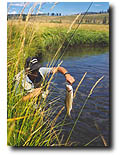 The
secrets to the Gibbon River are under lock, and only the patient The
secrets to the Gibbon River are under lock, and only the patient
and observant angler will learn the combination. Deep pools and
undercuts harbor large brown trout and the elusive grayling. Riffles
and pockets hide rainbows and brook trout. This stream gives the fly
fisher the choice of an easy or a very challenging day.
Good fishing is where you find it, and
numerous small streams and lakes in the northwestern quadrant of the
Park are available to those willing to explore the backcountry.
Blacktail Deer Creek - Brook Trout
This lovely tributary to the Yellowstone River is 7 miles east of
Mammoth on the Mammoth-Tower Highway. Blacktail Deer Trail follows the
creek along the 4-mile stretch downstream to the Yellowstone. The fishing
is excellent for richly colored brook trout in the 9- to 10-inch range.
During terrestrial time, July through September, the trout ravenously
attack grasshopper, beetle, and cricket patterns. Easy access and good
fishing make this one of our most popular small streams. The fishing
on the upstream side of the highway is also good and receives a lot
less pressure.
Duck Creek - Brook-Brown-Rainbow
Duck Creek is good-sized meadow stream located 8 miles north of West
Yellowstone, then east off Highway 191 on the Duck Creek Road. Formed
by the waters of Campanula, Gneiss, and Richards Creeks, this fine stream
meanders its way through country heavily populated by bear and moose.
In spawning season. Duck Creek's small population of resident fish is
bolstered by brown, brook, and rainbow trout averaging 16 inches that
migrate from Montana's Hebgen Lake. Pale Morning Duns and Gray and Green
Drakes can bring the fish to the surface during June and early July.
Terrestrials such as ants, beetles, and grasshoppers are a must in late
summer. Look for mayfly activity on overcast days and terrestrial action
on bright, sunny, and windy days. Duck Creek is one of the few waters
in Yellowstone Park that suffered as a result of the fires of 1988.
However, the good water years of 1993, 199$, and 1996 are gradually
reducing the heavy siltation caused by the fires, and necessary habitat
for both resident and spawning trout is now available.
Fan Creek - Brook-Cutthroat-Rainbow
This tributary to the Gallatin River, located at Mile Marker 22, 22
miles north of West Yellowstone on Highway 191, is reached by taking
the Fawn Pass Trail, then taking a left onto the Sportsman Lake Trail.
A small meadow stream, Fan Creek holds healthy populations of cutthroat
and rainbow trout, along with the occasional large brown. Baetis, Flavs, Green Drakes, and Pale Morning Duns are plentiful, and there
are some caddis hatches. In late summer, terrestrials are good producers
here. For such a small stream, Fan Creek holds trout that can be exceedingly
selective and difficult to catch. Attractor flies work fine on most
small streams, but here we recommend matching the hatch.
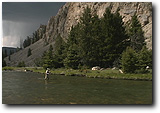 Gallatin
River -
Brook-Brown-Cutthroat-Rainbow-Grayling-Whitefish Gallatin
River -
Brook-Brown-Cutthroat-Rainbow-Grayling-Whitefish
The Gallatin begins as an icy trickle leaving remote Gallatin Lake at
nearly 10,000 feet in elevation. On the first half of its 12-mile journey
downstream to Highway 191, the frigid water of the Gallatin provides
little in the way of trout habitat. About halfway between the lake and
the highway the habitat improves, but the river
remains a small-fish proposition-mostly cutthroat and brook trout, with
a few rainbows and browns.
Once in view of the highway, 20 miles north of West Yellowstone, the
river develops more character. Willows begin to line the riverbank,
and as the water meanders through them, undercut banks and weed beds
begin to appear. Fish numbers and sizes increase proportionally with
the improvement of the holding water and increase in insect life. The
river is still ice cold here and is usually discolored by snowmelt until
July 4. Immediately after clearing, both aquatic and terrestrial insect
activity increase.
River access is easy all the way to the Park's north boundary, as the
river flows parallel to the road. Numbered roadside mile markers are
a quick way to identify your location. The river comes into view on
the east side of the road at Mile Marker 20 and for the next 11 miles
remains in the Park. (Keep in mind that the mile-marker number is the
same regardless of your direction of travel.) Once you leave the Park
near Mile Marker 31, your Yellowstone Park fishing permit is no longer
valid; you'll need a Montana fishing license from here downstream. This
stretch of water is a pleasant mix of mountain freestone and meadow
water, with enough undercut banks to house larger fish. Boulders, pockets,
pools, and eddies combine to present a challenge to any angler, with
enough variety to suit any mood or technique.
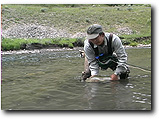 The
Gallatin has a good population of rainbows, along with browns, cutthroats,
grayling, and whitefish. This looks like classic rainbow water, and
the average trout runs II to 12 inches. First-timers on the Gallatin
are often surprised by browns twice that size, however. They're also
surprised by where they hold. The browns are in the obvious deep runs,
pockets, and undercuts, but they also turn up in water so shallow that
their backs are out of the water. We relearn this lesson every year:
Keep your eyes open for every inch of water. In the Gallatin, the big
fish are often in small-fish water, and the small fish are where we
think the big fish should be. The
Gallatin has a good population of rainbows, along with browns, cutthroats,
grayling, and whitefish. This looks like classic rainbow water, and
the average trout runs II to 12 inches. First-timers on the Gallatin
are often surprised by browns twice that size, however. They're also
surprised by where they hold. The browns are in the obvious deep runs,
pockets, and undercuts, but they also turn up in water so shallow that
their backs are out of the water. We relearn this lesson every year:
Keep your eyes open for every inch of water. In the Gallatin, the big
fish are often in small-fish water, and the small fish are where we
think the big fish should be.
Because the Gallatin hosts an incredibly
diverse insect population-more than 200 species of mayflies, caddis,
and stoneflies-attractor flies are often more successful than match-the-hatch
patterns. The notable exceptions are hatches of Pale Morning Duns, Flavs,
and Green Drakes.
Gardner River - Cutthroat-Brook-Brown-Rainbow-Whitefish
From its source at Joseph Peak west of Mammoth to where it crosses the
Norris-Mammoth Road at the lower end of Gardner's Hole, the Gardner
River is strictly a small brook trout fishery. On this part of the stream
(along with Panther, Indian, and Obsidian Creeks) children 11 and younger
may fish with bait. This is a popular place for family camping, and
serious fly fishers should move downstream. On the east side of the
Norris-Mammoth Bridge are Sheepeater Cliffs, and there's good fishing
for 8- to 10-inch brook trout here. Below Sheepeater Cliffs, the river
drops 150 feet over Osprey Falls into 800-foot-deep Sheepeater Canyon.
The river in this area is practically fishless, and getting into and
out of this canyon is dangerous. The river becomes fishable again about IV2 miles below Osprey Falls. The only access to this
section is at the Tower Bridge, via the Mammoth-Tower Road. Only Vi mile of fishable water lies upstream of the bridge before the hazards
of hiking begin to outweigh the rewards of catching a few pan-sized
trout. Downstream from the Mammoth-Tower Bridge the river flows through
Gardner Canyon, a pleasant 3-mile hike along sagebrush and greasewood
trails. Lava Creek enters from the east, adding nutrients and a few
cutthroat trout to the river, which they share with brooks, browns,
rainbows, and a few large whitefish. Most of the stream is typical canyon
water, with boulders, riffles, and runs. There are also a few nice pools
in this stretch. The middle of this short canyon is accessible via a
trail behind the Yellowstone School and Mammoth housing area. The 45th
Parallel Bridge-so called because its halfway between the equator and
the North Pole-crosses the Gardner River at the bottom of the canyon.
From here to the north boundary of the Park, the river plunges through
3 miles of cascades and boulders, known locally as Shotgun Chutes, before
entering the Yellowstone River at the town of Gardiner, Montana. Although
the river flows alongside the road and access is easy, the character
of the water makes fishing difficult. September, grasshoppers) beetles,
and gargantuan Mormon Cricket patterns will bring trout to the surface.
The average resident trout here run 10 to 12 inches, but an occasional
lunker brown will make you wish you'd put on fresh backing this season.
Autumn is a colorful time on the Gardner. Aspen leaves are turning red
and gold, bull elk are bugling and sparring for their harems, and big
brown trout begin migrating up the Gardner from the Yellowstone River.
While the fishing in September is okay, October is the best time to
try for fall-migrating fish. Rainy or snowy days are best for fishing
big streamers, nymphs, and Baetis mayfly imitations to fall-run
browns. Even on bright, sunny days, the Gardner is one of those rare
rivers where you can still get into migratory fish with big attractor
dries and terrestrials. Regardless of the weather, we always make it
a point to fish the Gardner every fall.
Gibbon River - Brook-Brown-Rainbow-Grayling-Whitefish
The Gibbon River has it all: meandering meadow stretches with deep undercuts
inhabited by big browns, riffles with rambunctious rainbows, pockets
holding voracious brook trout, and secluded pools hiding the elusive
grayling. After leaving its main sources, Grebe and Wolf Lakes, the
Gibbon flows through a maze of downed lodgepole pines until crossing
the Norris-Canyon Road on its way to Virginia Meadows. This section
of stream is best left to its resident moose and bear, as human travel
is next to impossible amid the downed timber. Virginia Meadows begins
on the downstream side of the Norris-Canyon Highway and offers fine
fishing for
small brook trout. There's a picnic area
at the lower end of the meadow, accessible via the Virginia Cascades
Road. The entrance to this one-way drive is about 2 miles downstream
from the meadow and follows the river back upstream to both the cascades
and the picnic area. Below the cascades and for the 2 miles downstream
to Norris Junction, the water is full of pockets, pools, and undercut
banks that hold plenty of browns, brooks, rainbows, and the occasional
grayling. Its best fished with a high-floating dry fly bounced over
and through the scattered cover that lines the stream.
At Norris Junction, with the addition
of water from Solfatara Creek, the river changes its character, becoming
noticeably deeper and wider as it passes the campground and crosses
the Norris-Gardiner Road. From here to Elk Park, a distance of about
2 miles, the river flows behind Norris Geyser Basin; the browns become
larger, the brook trout fewer, and the rainbows far between. Geothermal
features start to appear along the stream, adding both nutrients and
water and preparing the habitat for increased insect life as the river
turns the corner into Elk Park.
If you head south at Norris Junction,
Elk Park will be the first meadow on your right and a great place to
see elk. The river is like a spring creek here, with slow-moving water
and tremendously undercut banks. The insect hatches also resemble those
of a spring creek: Baetis (Blue-Winged Olives), Pale Morning
Duns, Brown Drakes, and Green Drakes. Caddis include Oecetis and Lepidostoma. This is on-your-knees fishing to wary brown
trout. Sharply honed stalking skills and a high degree of patience are
required to land fish here. You must be able to focus and concentrate.
The only time we recommend searching the water with a fly is during
terrestrial season.
As you journey downstream from Elk Park
the elevation drops radically, and there's a mile of unproductive, shallow
rapids next to the road. The gradient then levels and the water slows
at the Gibbon picnic area) upstream of Gibbon Meadows.
The scene here is much the same as at
Elk Park, only this meadow is much larger. The depth is also more uniform,
and the flow more even, in this stretch. There are fewer undercut banks
and weed beds, and it isn't as obvious where [ trout hold. If you don't
spot any surface feeding, look for fish holding in the shadows next
to the bank. Like Elk Park, I Gibbon Meadows can be difficult fishing,
but its a lot of fun for someone who enjoys mixing hunting with fishing.
Leaving Gibbon Meadows behind, the river
becomes pocket water all the way down to Gibbon Falls, a distance of
5 miles. This is fun fishing for anyone who likes searching the water
with attractor flies for 8- to 12-inch fish. Browns and rainbows predominate
in this, the Gibbon River Canyon, along with the occasional grayling
and small brook trout.
At Gibbon Falls the water drops 88 feet,
forming a barrier to migrating trout. The river here is a succession
of riffles, runs, and pools, custom made for the wet-fly and nymph angler.
Its good fishing during Junes Golden Stonefly emergence and a favorite
with many locals during grasshopper time. However, this section is especially
noted for its fine fall fishing.
In October, from Gibbon Falls 5 miles downstream to the rivers confluence with the Firehole at Madison
Junction, large brown and rainbow trout head into the river to spawn.
These fall-run fish, moving upstream from Montana's Hebgen Lake, attract
fishers from around the world.
This creek follows Highway 191 north
of West Yellowstone, from Mile Marker 11 upstream to Mile Marker 17.
Most of the fishing takes place along this stretch, because Graylings
headwater contains small fish and is located in trailless backcountry
that's often closed to human travel due to high grizzly bear activity.
Grayling Creek - Brown-Cutthroat-Rainbow
Grayling Creek is a medium-sized mountain
stream that offers excellent fishing during hatches. Green Drakes and
Pale Morning Duns (including PMD spinner falls), caddis, and Little
Yellow and Golden Stoneflies will bring the trout to the surface. Brown,
cutthroat, and rainbow trout average 11 inches, but those anglers willing
to hunt will find an occasional lunker.
Madison River - Brown-Rainbow-Grayling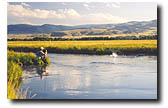
-Whitefish. National Park Mountain overlooks the beginning of the Madison
River, which is formed by the confluence of the Gibbon and Firehole
Rivers. It was here that a small group
of men with foresight conceived the idea of setting aside the natural
wonders of Yellowstone as a national park. The
Madison River has been called the worlds largest chalkstream. From Madison
Junction to the west entrance of the Park is a 14-mile journey. The
road follows the river for 10 of these miles, making access easy. The
fishing, however, is never easy. According to Charlie Brooks, in his Trout^ and the Stream (Crown, New York, 1974), only 20
percent ^ of those fishing this water catch fish. Success demands a
stealthy approach and all the concentration you can muster.
From Elk Meadow downstream to Big Bend,
then past Mount Haynes and Nine-Mile Hole to Riverside Drive, the river
is a succession of deep runs with undercut banks. The bottom is randomly
carpeted with lush weeds that reach the surface, creating a complex
mix of crosscurrents. Controlling drag is paramount to fishing this
stretch successfully. We advise long leaders and tippets to help achieve
drag-free floats.
This 9-mile chalkstream section is home
to several important trout stream insects. Mayflies include Baetis (BWOs), Pale Morning Duns, Gray Drakes, and Tricos. While several
caddis are available to the trout, we've found only Brachycentrus adults present in sufficient number to entertain rising fish. Salmonflies
are the predominant stone-fly and therefore the stonefly of choice.
This early-June hatch is extremely variable, confined to short sections
of riffle water where the habitat is ideal for the nymphs.
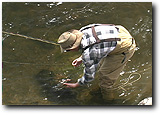 From
July through September, terrestrials form an increasing portion of the
trout diet. Good places to fish imitations are the meadow stretches
of Elk Meadow to Big Bend, then downstream to the bottom reaches of
this section, most notably Grasshopper Bank. At Riverside Drive, just
below Grasshopper Bank, the river loses its chalkstream character and
becomes freestone-riffle water. From
July through September, terrestrials form an increasing portion of the
trout diet. Good places to fish imitations are the meadow stretches
of Elk Meadow to Big Bend, then downstream to the bottom reaches of
this section, most notably Grasshopper Bank. At Riverside Drive, just
below Grasshopper Bank, the river loses its chalkstream character and
becomes freestone-riffle water.
The next 5 miles of river, from Riverside
Drive to the Barns' Pools, lacks holding water and is mostly unproductive.
With the exception of a few very short runs such as Shakey Beiley's,
the river in this section is not worth your time. Its just too shallow.
A half mile inside Yellowstones West
Entrance is a dirt road on the north side of the main road that takes
you down to the Barns Pools, named for the stables that used to house
the Park's horses and stagecoaches. When you reach the end of the road,
you'll be at Hole #2. Around the corner upstream is Cable
Car Run, and around the corner downstream are two more holes, locally
named, with great imagination, Hole #1 and Hole #3. For the next
3 miles downstream, the river winds northwest in a series of oxbows
to the Parks boundary. This portion of the river is only accessible
by hiking downstream from the Barns' Pools or upstream from the Bakers
Hole campground and the Montana state line.
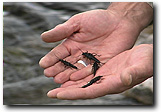 Many
refer to this part of the river as Beaver Meadows, because of thenumerous
beaver holes along the banks. This area is a haven for moose and bears,
which like the security of the willows and bogs and nearby thick stands
of lodge-pole pines. As the river meanders through this meadow, deep
pools and enormous undercut banks provide great holding water and security
for trout and whitefish. This stretch is primarily a fall fishery, hosting
great numbers of migrating trout that move upstream from Montana's Hebgen
Lake to spawn. A resident population of trout is virtually nonexistent. Many
refer to this part of the river as Beaver Meadows, because of thenumerous
beaver holes along the banks. This area is a haven for moose and bears,
which like the security of the willows and bogs and nearby thick stands
of lodge-pole pines. As the river meanders through this meadow, deep
pools and enormous undercut banks provide great holding water and security
for trout and whitefish. This stretch is primarily a fall fishery, hosting
great numbers of migrating trout that move upstream from Montana's Hebgen
Lake to spawn. A resident population of trout is virtually nonexistent.
Late September through October is the
time to fish the fall spawners in the Madison. Short days, cold weather,
and snow squalls signal both the fish and a hearty breed of fishers
that its time to return to the Madison. Heavy rods, large tippets, and
big flies are required to land these lake fish moving in to spawn. Fish
of up to 4 pounds are not uncommon.
For gear we recommend a 7-weight rod,
IX-2X tippets, and a good selection of big nymphs and streamers in various
colors. This type of fishing is not unlike steelhead and salmon fishing.
These fish are territorial, protecting their turf rather than actively
feeding. We believe in using big, bright flies to take advantage of
this aggressiveness.
Although we look forward to the fall
fishing each year, it marks the beginning of the end. November means
big snows, bitter cold, and the close of the season.
Straight Creek-
Brook Trout
This fine little brook-trout fishery flows both into and out of Grizzly
Lake. It's located along the Grizzly Lake Trail, about 6 miles north
of Norris Junction on the Mammoth-Norris Road. Above the lake. Straight
Creek provides little habitat for trout; below the lake, it merges with
Winter Creek and supports a good population of wild brook trout averaging
8 inches. In July there's a hatch of Green Drakes, providing fun dry-fly
fishing for eager brookies.
Tower Creek - Brook-Rainbow
This rough-and-tumble, medium-sized trout stream enters the Yellowstone
River near the Tower Falls carnpground. Upstream from the campground,
Tower Creek offers excellent fishing for 9-inch brook and rainbow trout;
the Tower Creek Trail parallels it. Below the campground, a well-traveled
trail takes you down to the Yellowstone River, where you can fish your
way upstream to the spectacular Tower Falls itself. The lower water,
from the Yellowstone River to Tower Falls, is best fished with high-floating
attractor flies such as Trudes, Wulffs, and H&L Variants. Above
the falls, upstream from the campground during July, August, and September,
try terrestrials such as beetles and grasshoppers.
|
